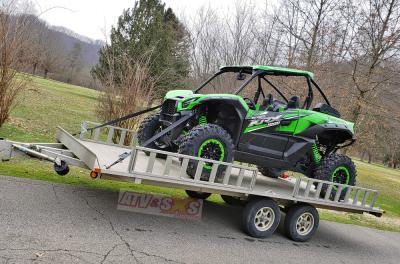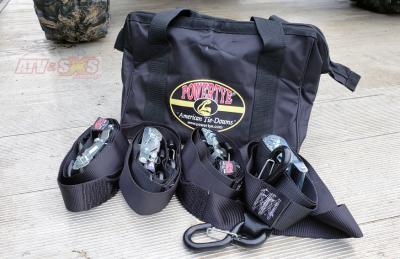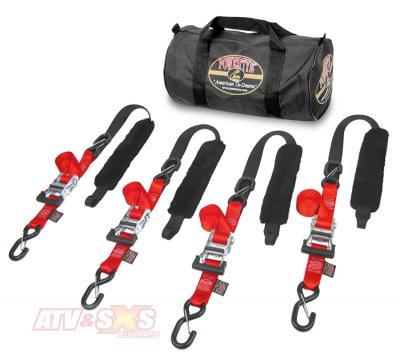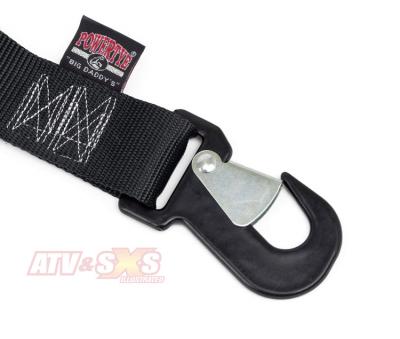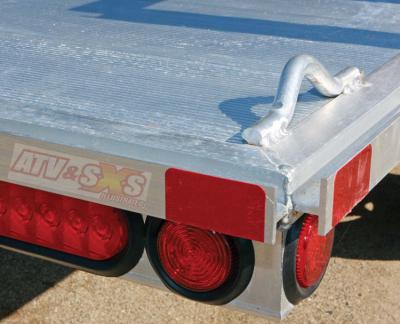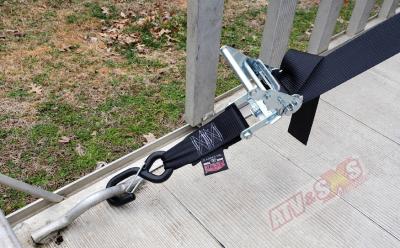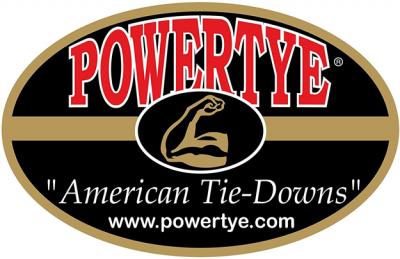If you’ve ever seen an ATV or UTV unload itself on the highway, you know the carnage is truly a sight to behold. We’ve seen it happen, and it would make Mr. Mayhem from the insurance commercials proud. What’s even more concerning is the danger to others on the road. Whether you’re off for a day on the dunes or trails, heading north to the deer camp, or hauling to the construction site, trailering your ATV or Side x Side is almost always part of the adventure. We can help you do it safely.
KNOW YOUR LIMITS – THE RIGHT STRAP FOR THE JOB!
A utility ATV typically weighs a little over 600 pounds but a high-performance Side x Side such as a Polaris RZR or Can-Am Maverick can top 1,600 pounds, and a heavy-duty machine like a John Deere Gator or Kubota RTV is close to 2000lbs! That’s just the start, and those numbers don’t include accessories such as bigger tires or a bed full of work tools. You need to size tie-down straps accordingly. While the typical 1” cam style straps can efficiently hold a sport ATV or dirt bike, they’re in no way suitable for a much heavier machine, and your tie-down straps are not the place to skimp. Protect your investment with a high-quality tie-down strap capable of handling the load of your machine. After decades of hauling and towing, here is what we look for.
RATCHET STRAPS PROVIDE STRENGTH and SECURITY.
Strap makers typically list the “working” load limit of the strap which is actually one-third of its ultimate breaking strength. We prefer to use ratchet straps because of the consistent tension they provide. Because the ratchet is actually a mechanical mechanism and can only be released manually, the straps tend to stay tight in travel. It has been our experience that light duty cam straps often lose their bite on the material and loosen over time, or simply slide on a wet or frayed strap. With anything bigger than an ATV, ratchet straps are the way to go, but not all are created equal. Yes, you can pick up a set at Home Depot, and they’re suitable for strapping down a kayak or lighter load, but we prefer the heavier ratchet mechanism and thicker strap of a high-quality tie-down like those from POWERTYE.
POWERTYE – THE STRAPS WE TRUST
We’ve been using the POWERTYE 2” ratchet straps for many years, and having hauled hundreds of vehicles, we can vouch for the high-quality construction and reliable security the POWERTYE products offer. Whether on the interstate or a rough two-track trail, they hold our machines securely to the trailer, and in all weather conditions. The heavy-duty mechanism has yet to stick or jam. The springs, gears and steel used are all plated and resist corrosion very well, and the overall quality is excellent. Just the thickness of the strap itself will reassure you that you have a quality product. The strap is thicker than the bargain basement brands, it resists fraying, and is available in several widths and colors. We opted for maximum holding capacity with 2” wide straps. One feature we really like is the handy soft loop that is built into the strap. It’s perfect for fastening around frame tubes.
POWERTYE has been building high quality tie-down tools for three decades, and as off-road vehicles grew in size and weight, they continually upgraded their lineup to exceed what was needed to secure the load. Today the PowerTye lineup covers the range of off-road vehicles, but they’ve also made it easy by creating kits. We’re currently using a 2” ratchet kit which includes four ratchet style tie-downs with a handy carrying bag. Thankfully the bag organized all the tie-downs floating around in the back seat of our truck.
TRAILER ATTACHMENT POINTS – ALUMA MAKES IT EASY
Even the best tie-down strap is only as good as the trailer attachment point. Looping a strap around a bed rail is a quick way to cut any strap, greatly reducing its load carrying capability. Thankfully ALUMA eliminated that problem.
You can’t beat the ALUMA trailers for build quality, ease of use, and reliability. We’ve been using the Aluma 8816 dual axle ATV trailer for years, and it has never let us down. All we’ve ever done for maintenance was check the wheel bearings a few times, and replaced the battery to its electric brakes. We love how the ramps safely lock into the side and end rails for loading and unloading, but one of its best features is the integrated tie-down attachment points. They’re not just bolted to the bed, they’re welded to it. It doesn’t get any safer. The Aluma experience goes beyond us though. Even Kawasaki has been running Aluma trailers, crisscrossing the country with their off-road fleet.
Whatever trailer you run, you must pick a quality attachment point. Whether it’s welded on like with our Aluma trailer, or a bolted down loop, you need a solid anchoring point. You'll be transporting equipment that has cost you a pretty penny, and cheap tie-downs or poor anchor points are not the place to try and save a few bucks.
---------------- IMPORTANT TRAILERING TIPS ---------------
We recommend using a minimum of four straps for each UTV being hauled, with each strap rated for the full weight of your machine. If your vehicle weighs 1,400 pounds, then each strap should have a “working” load limit tag of 1,400 pounds or higher. The reason is, during sharp turns one tie-down will need to restrain the total force of your load at any one point of the turn and when braking.
- BALANCE THE WEIGHT
Position the machine on the trailer with the weight equally distributed over the trailer axle, or slightly forward. When properly loaded the trailer should have no less tongue weight than when empty. This is important as too little tongue weight causes the trailer to sway on the highway, and it can become uncontrollable. A little tongue weight is vital for safety.
- STRAP LEVERAGE – 4 EQUAL POINTS
To ensure your ATV or SxS won’t move or shift in transit, attach straps at a frame or structural member that is attached to the frame. Frame tubes, bumpers, and brush guards work excellent, but attach at a point where the hook or loop cannot slide, and take care not to pinch any wires or cables. Avoid any sharp edges that can cut or fray your strap. We HIGHLY recommend a ratchet strap for this as you can put down pressure on the vehicles suspension, effectively making that work to keep the straps tight during transit. And don’t worry about the naysayers claiming it damages the suspension. Your shocks are made to support the vehicle weight, and unless you strap it down for months on end, there will be no problem. Keeping the vehicle from moving from side to side and back to front is achieved with tie-downs in four opposite corners, creating equal tension and balance.
- WORKPLACE TENSION
You trailer attachment point is ideally a loop welded to the trailer floor, or a D-ring bolted to the trailer deck, but if your trailer has neither of these, looping your strap over the side and immediately next to or around a structural member will work. Just be sure the strap cannot slide during transit, and will not be cut by any sharp edge. Again, you’ll need to ratchet down evenly until all straps are tight and the suspension is compressed firmly but not fully, which will help maintain strap tension. Check all straps again for even tension and you’re done! Finally, when you’ve double checked all straps, do not forget the all-important proclamation, “That’ll hold!”, thereby establishing your mastery of the procedure. Your machine is now properly secured and ready for travel.
(Note: If you’re using new tie-downs, re-tighten after a few miles—new straps sometimes stretch a bit the first time they are used.)
POWERTYE
Toll Free: (800) 659-0575
ALUMA TRAILERS
Toll Free: (866) 415-3285


